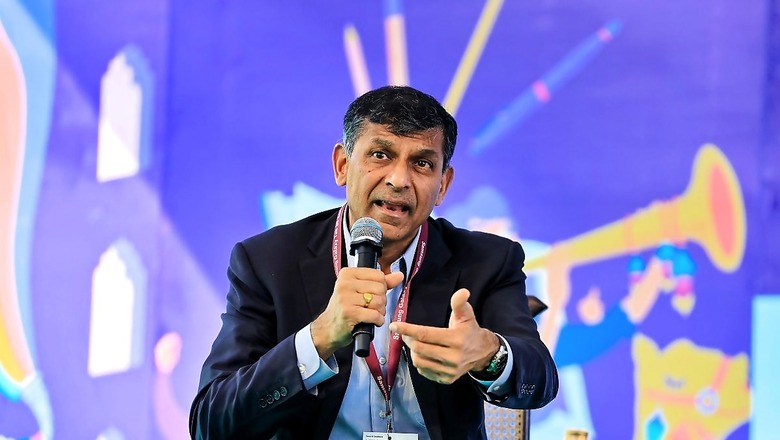
views
Former RBI Governor Raghuram Rajan is set to advise the Tamil Nadu government. In reviewing his policies and the results they bore for the Indian public, one may be right about being wary of his political influence. As a theorist, his stance against growth-oriented policies has consistently been seen as unsuitable for an emerging economy like India’s.
Raghuram Rajan’s Economic Policies: Out of Touch with India’s Realities
Raghuram Rajan’s tenure as Governor of the Reserve Bank of India (RBI) drew significant attention. While he is often lauded internationally for his economic insights, it is difficult to overlook how some of his policy recommendations seemed out of touch with India’s on-ground realities. He is widely celebrated for his sharp intellect and no-nonsense approach, especially in global circles —‘especially’ being a keyword here.
The truth is that Rajan’s economic philosophy, rooted in textbook theory and developed in the hallowed halls of international institutions like the IMF, fails to consider the everyday challenges that India faces. For all his talk about stabilising inflation, cleaning up banks, or curbing fiscal deficits, Rajan appears frustratingly out of touch with the steps needed to make these happen—growth, job creation, and policies that address the systemic issues of inequality and unemployment. His ideas, though academically sound, feel like a prescription for another country entirely.
Inflation-First Obsession: Sacrificing Growth for Stability
Rajan is a self-proclaimed inflation hawk, insisting that price stability is the foundation for sustained growth. India is a developing economy where growth can’t be sidelined in favour of univariate measures of stability. While comparisons with China are continuous, they require a realistic look at a need to grow, and fast, in order to tackle poverty, create jobs, and improve living standards.
When Rajan was the RBI Governor, he kept interest rates high to curb inflation. His rationale was simple—by tightening monetary policy, he could bring down prices. But this singular focus came at the cost of economic expansion. High interest rates stifled private sector investment, making it harder for businesses to access cheap credit. Small and medium enterprises (SMEs), which are the real backbone of India’s economy, were hit particularly hard.
Rajan’s obsession with inflation meant that growth was sacrificed on the altar of stability. The result? Sluggish job creation, stagnant wages, and an economy that couldn’t pick up steam. India, with its young and rapidly growing population, cannot afford this kind of policy. The primary concern should be how to generate jobs and increase productivity. But Rajan’s policies seemed fixated on a long-term vision of stability suitable for a mature economy such as the USA’s, completely disregarding the urgency of necessary growth.
In an economy where millions of young people are entering the workforce each year, the last thing necessary is to stifle growth.
Mishandling NPAs: Overcorrecting and Strangling Growth
Rajan’s approach to fixing non-performing assets (NPAs) in the banking sector verged on the draconian. He pushed for a harsh clean-up of bank balance sheets, demanding a crackdown on bad loans. What this led to was a period of extreme credit tightening, especially in public sector banks. Rather than continuing to lend and support business growth, banks became overly cautious, shutting the tap on credit flows.
For an economy like India’s, where access to credit is already limited and SMEs rely heavily on borrowing to stay afloat, this was a disaster.
Rajan’s zeal for tackling NPAs was understandable, but his method was too harsh, too fast. Instead of promoting a gradual approach that would allow banks to fix their balance sheets while continuing to lend, Rajan’s policies forced a credit squeeze that hampered the economy.
The irony is that the very sectors that needed credit the most—agriculture, small manufacturing, and informal businesses—were the ones left struggling.
Rajan may have been looking at the long-term health of the banking sector, but his tunnel vision ignored the immediate needs of the economy. It is necessary to revisit such a misstep for a state like Tamil Nadu that is seeking investment in order to continue on its growth path. Will external investment come at the cost of indigenous industry?
Fiscal Austerity: A Misguided Solution for a Developing Nation
Rajan’s emphasis on austerity overlooks the fact that India is still a developing economy with deep-seated structural problems that need aggressive public spending to fix. India’s infrastructure is still lacking, public services like healthcare and education are underfunded, and millions of people are trapped in poverty. Rajan’s suggestion of cutting back on public expenditure to balance the books seems cruel in this context.
How can a country that still hasn’t met its basic developmental needs afford to tighten its purse strings with regards to basic welfare? India’s fiscal challenges are real, but there is no simplistic solution such as austerity for it. What is needed is targeted, productive investment in sectors like infrastructure, education, and healthcare in order to stimulate growth and improve the country’s long-term prospects.
But Rajan’s focus on reducing the fiscal deficit seems completely out of touch with this need. His advice to curtail public spending ignores the fact that millions of Indians still rely on government schemes for their livelihood and survival. Rajan’s disdain for policies like farm loan waivers or public employment schemes like MGNREGA stems from a place of theoretical purity. But in India, where many still live in extreme poverty, these programmes are essential lifelines. Rajan’s stated solutions often miss the mark when addressing India’s complex social and economic landscape.
The Samsung Protests: A Wake-Up Call
The recent worker protests at Samsung’s factory in Tamil Nadu highlight how out of touch Rajan’s ideas are with India’s realities. As global companies look to diversify their supply chains under the China Plus One strategy, India is poised to become a major manufacturing hub. At the same time, there is a very strong reason to suspect that China, facing the threat of companies moving production away, could quietly fan the flames of labour unrest in India to slow down growth.
As geopolitical rivalries intensify, India’s ability to navigate these challenges will depend on more than just fiscal prudence and inflation control—it will require a bold strategy that prioritises domestic growth and labour law restructuring. Leaky schemes involving freebies—such as the ‘khatakhat’ and ‘revdi’ politics currently taking centre stage—are likely to hinder progress in this cause in the near to medium term.
Conclusion: Rajan’s Ideas in an Era of Shifting Geopolitics—Too Little, Too Late
Raghuram Rajan’s policies may work in a different nation, but today, they are not just outdated—they are downright dangerous. His obsession with inarticulate and reactionary fiscal politics fails to address the issues that India faces. The world is shifting, and India has the opportunity to become a global manufacturing hub.
India needs more than a man of politics masquerading as an economic soothsayer. We need labour reform, investment in infrastructure, and a dynamic strategy that not only stabilises the economy but pushes for ambitious growth. Rajan’s ideas may win him accolades in global circles, but they’re out of sync with the reality of a country striving to rise on the global stage. India cannot afford to play it safe anymore—it’s time to take bold steps to secure our future, not just for financial elites, but for the millions who drive this economy forward.
Dhruwal Kushwaha is an observer of economic policies and analyses them in context of real-world challenges. When he’s not questioning out-of-touch ideas, he’s exploring what makes economies and businesses tick. Views expressed in the above piece are personal and solely those of the author. They do not necessarily reflect News18’s views.
















Comments
0 comment